How to Sharpen Broadheads
We may earn revenue from the products available on this page and participate in affiliate programs. Learn More ›
During my bowhunter safety course, the instructors showed us a video of Fred Bear sharpening a broadhead with a mill file while discussing the importance of sharp broadheads. The instructors then showed the class the difference between sharp and dull broadheads using rubberbands to represent blood vessels. The sharp heads popped the bands without effort and the dull heads pushed them to the side. Since I was already a knife nerd and obsessed with keeping my knives sharp, the lesson about sharp broadheads stuck with me. I believe it is the most important component besides shot placement for making an ethical kill.
If you want to ensure your broadheads are absolutely deadly, here’s how to sharpen just about any head, whether it be an old-school Zwickey or Bear, a single bevel, three or four-blade, replaceable blade, or mechanical broadhead.
Topics Covered
- What You Need to Sharpen Broadheads
- How to Sharpen a Fixed, Two-Blade Broadhead
- How to Sharpen a Single-Bevel Broadhead
- How to Sharpen a Three-Blade Broadhead
- How to Sharpen a Mechanical Broadhead
- How to Sharpen Replaceable Blades
- FAQs
What You Need to Sharpen Broadheads
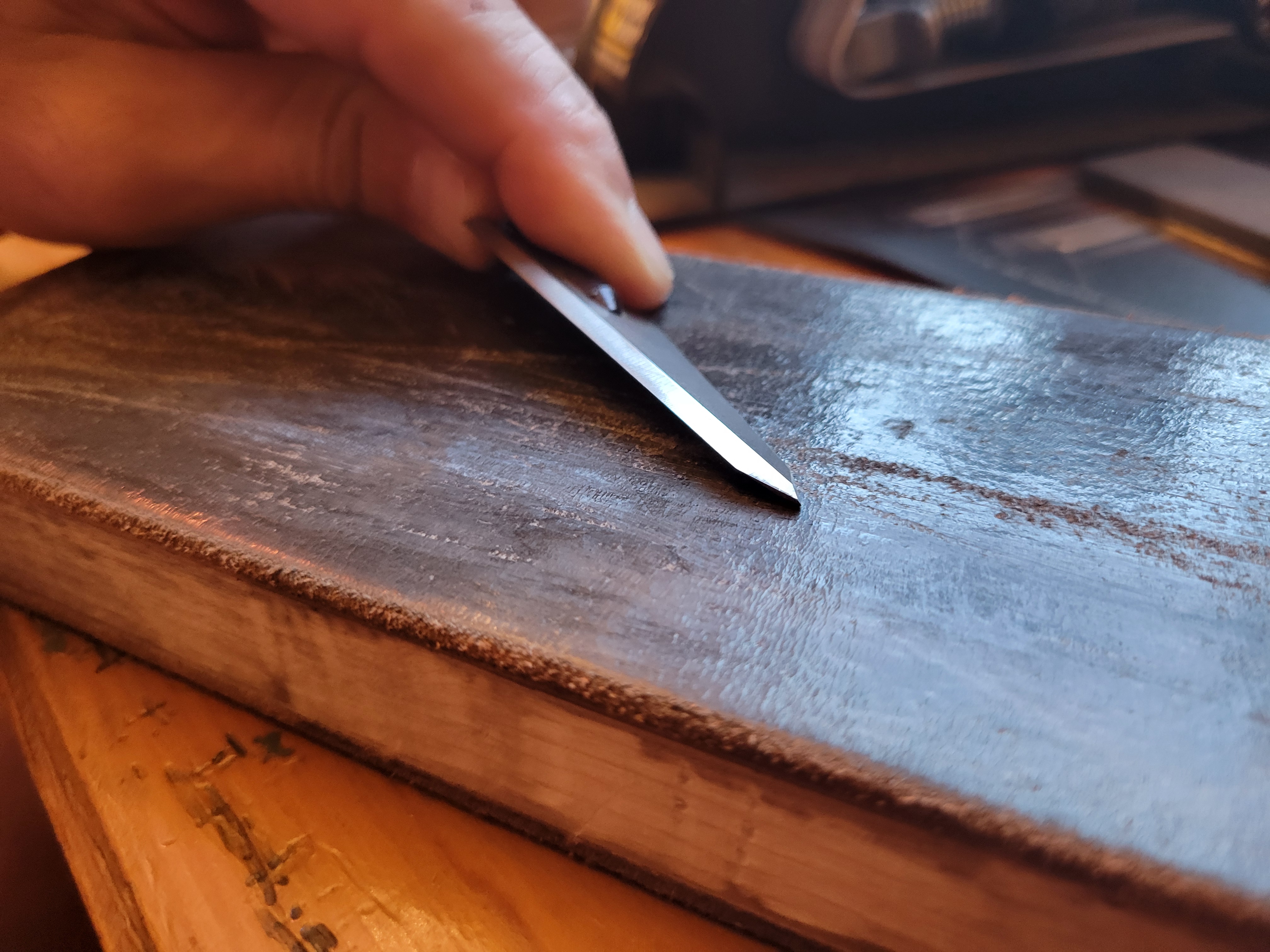
Photo by Drew Conover
Stone and Strop Sharpening Method
- Two-sided sharpening stone
- Leather Strop and Stropping Compound
- Optional: Fixed angle sharpening system like the Work Sharp Precision Adjust
A sharpening stone is excellent for all types of heads. You’ll need a two-sided stone or a dual-grit diamond stone. The stone should have a coarse side for removing edge damage and and a fine grit for honing. I use a Fallkniven DC4, which is a quality, pocket-size stone. A leather strop is optional, but it will really take the sharpness to another level. I highly recommend a large, wood-backed leather strop, which works wonders for knives and broadheads.
Belt Sharpener Method
A belt sharpener with various grit belts is the fastest way to sharpen fixed and replaceable blade broadheads. I use a Work Sharp Ken Onion with the Blade Grinder Attachment, but a regular bench belt sander would work with belts up to 800 grit.
On a belt sharpener, you will create a slight convex edge, which is generally tougher and more resistant to rolling and chipping. With some practice, you will be able to get mirror-polished edges that easily shave hair.
Sharpening Accessories
I like to use an old arrow that’s cut to about 8 inches to hold heads while sharpening. This “handle” gives extra control and is especially useful when using a belt sander.
You won’t see me wearing gloves in the photos accompanying this article, but I’m a professional knife sharpener with a lot of experience. If you’re new to sharpening, I recommend wearing thin leather gloves or cut-resistant gloves while sharpening broadheads. That’s because it’s usually necessary to hold broadheads by one of the blades, which obviously adds a risk of nicking yourself.
How to Sharpen Two-Blade Broadheads
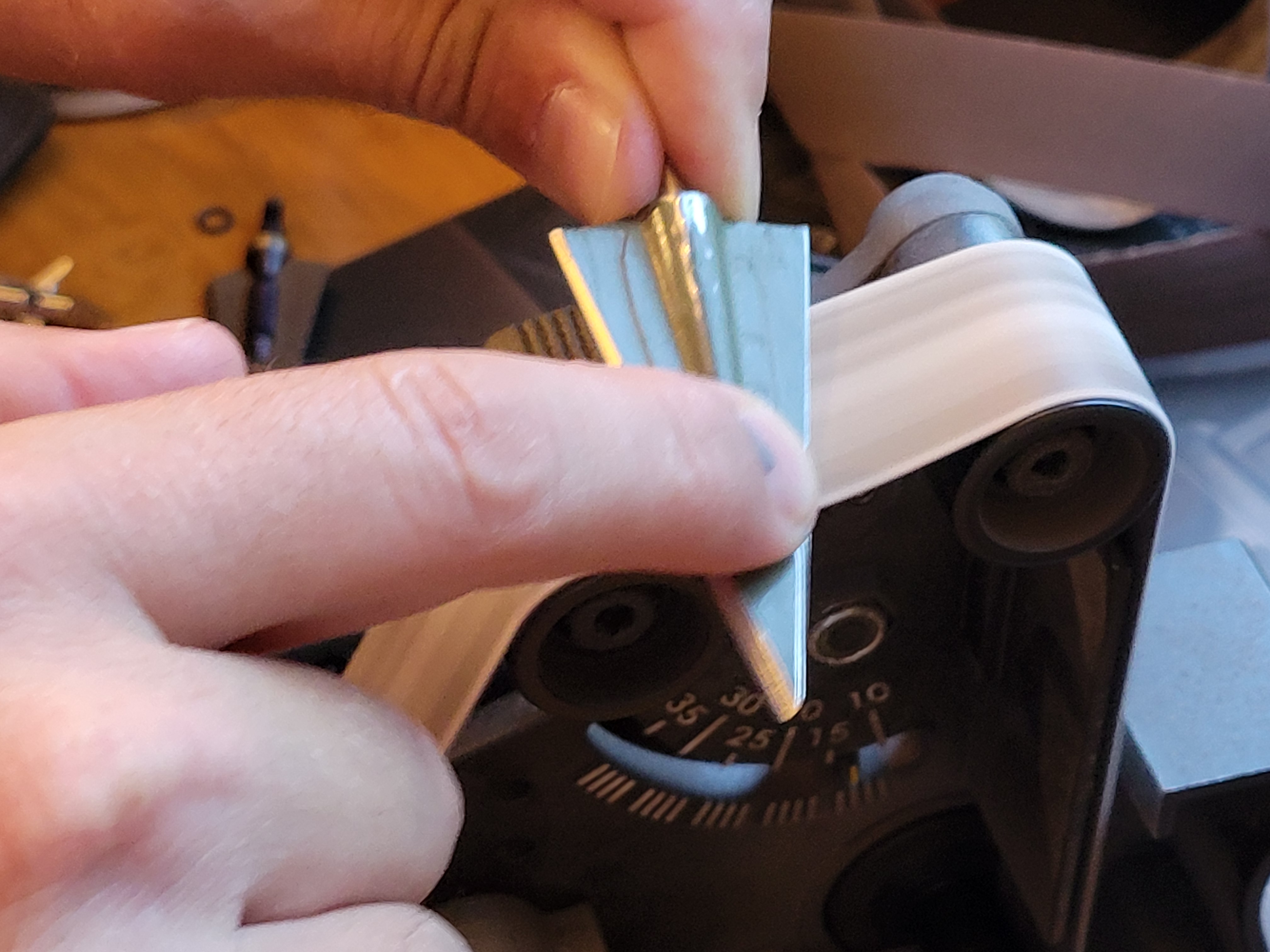
Photo by Drew Conover
The classic two-blade broadhead is fairly easy to sharpen. It’s essentially the same process as how to sharpen a knife. You can use a stone, belt sander, or fixed-angle system for these heads.
The most challenging part will be keeping a steady angle while making your passes on the stone or belt. I recommend everyone learns to freehand sharpen on a stone because it’s a great skill to have, and it’s very fast once you get the technique down. A stone is also much easier to pack on a hunting trip than a sharpening system. But, if you want guaranteed results, a fixed sharpening system like the Work Sharp Precision Adjust is the easiest way to get super sharp heads.
With a fixed-angle sharpener or freehand, you’ll want to match the factory sharpening angle. It’s helpful to color the edge with a permanent marker so you can see where you are removing material. Adjust the angle until you’re removing material evenly across the bevel.

With any of the sharpening tools, use slow, even passes until you raise a nice burr on the whole edge, then repeat on the other side. After you’ve raised a burr on all four edges on both coarse and fine stones or belts, you can move to a strop.
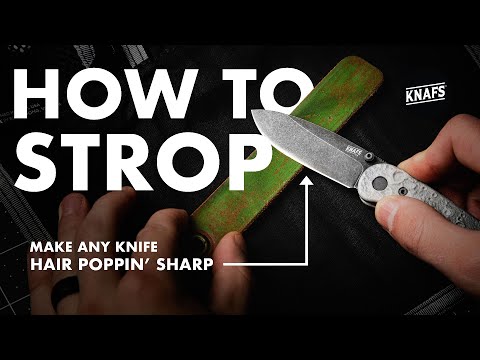
Stropping polishes an edge, and it’s a great thing to do between hunts to keep broadheads sharp. Most strops have two sides so you can apply a coarser compound to one and a finer to the other. Stropping is a lot like sharpening on a stone, except you’ll use much lighter pressure. Hold a consistent angle and drag the broadhead across the surface. Be sure to pull the blade with the edge facing away from you, so that you don’t cut the leather.
Read Next: Best Knife Sharpeners
How to Sharpen Single Bevel Broadheads
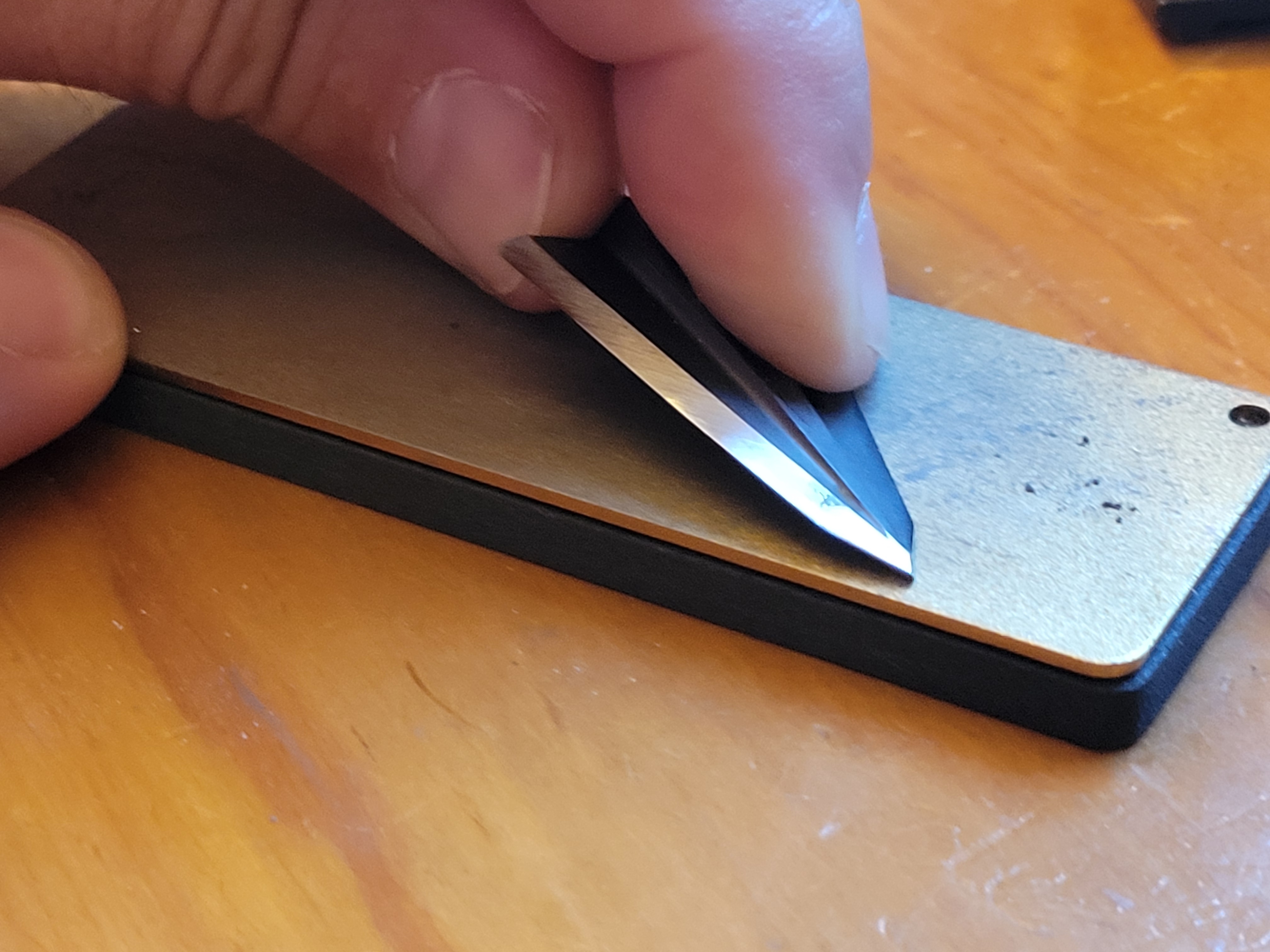
Photo by Drew Conover
Sharpening single bevels is a bit different than other heads, but it’s actually pretty easy to get the hang of it. Lay the bevels on your stone and start making passes — the whole bevel should be in contact with the stone. You will easily feel (and see) when you have the correct angle.
Flip the broadhead to the flat side and use a strop to remove the burr you created — don’t use a stone. A few passes on the strop will buff away the burr, and you will be left with a very sharp broadhead.
As with two-bladed fixed heads, it can be helpful to color the whole bevel in permanent marker to see where you are contacting the head with the stone. It will also help you see low spots so you can flatten the factory grind if needed.
I don’t use belt sharpeners on single bevels, because they aren’t designed to be convex grinds. They work best at a flat angle, so stones are really the only way to go for these types of heads. They can also be clamped into guided systems and sharpened that way, but stones are still the most effective in my opinion.
Read Next: Best Single Bevel Broadheads
How to Sharpen Three-Blade Broadheads
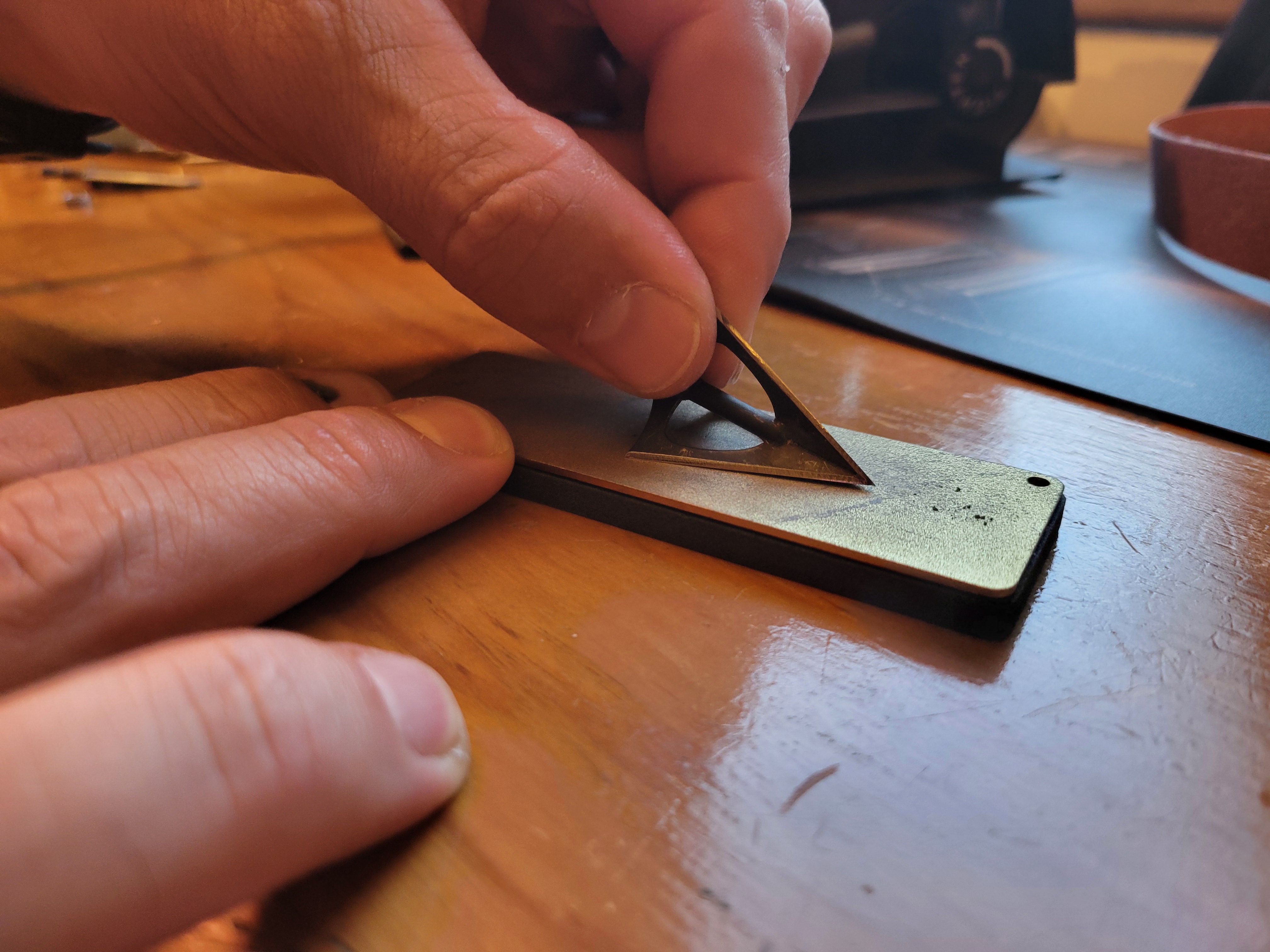
Photo by Drew Conover
A three-blade broadhead may just be the easiest broadhead to sharpen, and a stone is all you need. Simply lay the broadhead down so that two of the blades are on the stone, and one is sticking up. Keep the blades in contact with the stone and apply even pressure as you run the head back and forth on the stone. Check to make sure you have raised a burr on the whole length of both edges, and once you have, just rotate the head, and do the next side the same way. One more rotation, and you will have raised a burr on all six edges. Now repeat this on the fine stone and then strop.
When you’re stropping, be sure to have the tip trailing, otherwise, you’ll end up with a big V shaped slice in the leather. There are no tricks with these heads. They’re easy to hold, easy to sharpen, and it doesn’t take much practice at all.
I don’t recommend doing these on a belt unless the belt is wider than the widest spread on the broadhead. It’s do-able, but you can also easily ruin a head on a belt sander.
How to Sharpen Mechanical Broadheads
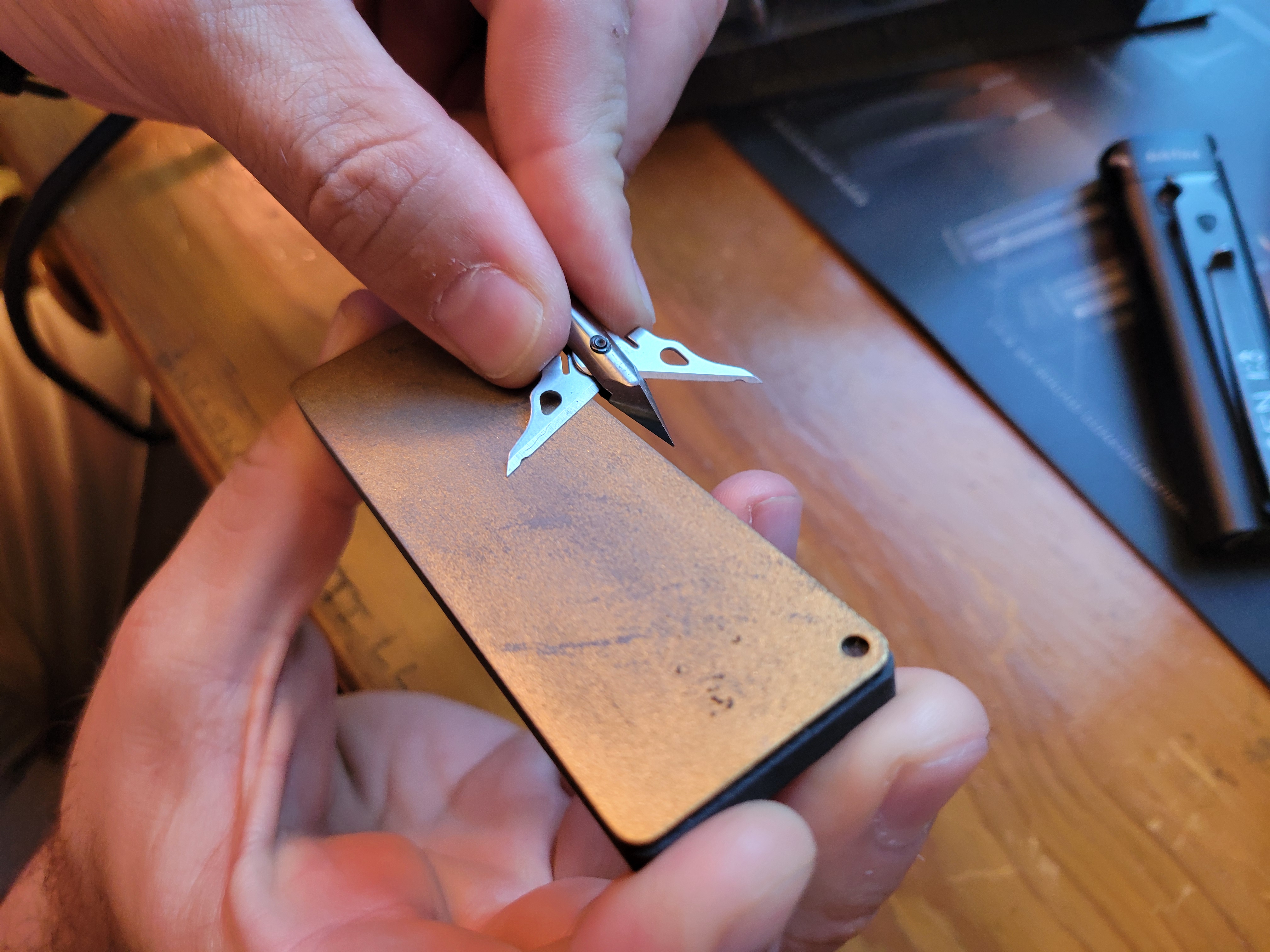
Photo by Drew Conover
When a mechanical becomes dull you can replace the whole broadhead or its blades — both can get costly and leave you with a false sense of security. In Outdoor Life’s broadhead test, many of the mechanicals were sharp, but had dull spots, especially toward the ends. So it’s wise to improve on their out-of-the-box sharpness with a fine stone or strop.
The difficult part of sharpening a mechanical is holding the blades still. But, with a little practice, you should be able to hold the head still while you run the stone back and forth across them. A sharpening stone with a base makes the process easier because you can use both hands.
Move the stone back and forth until you have raised a burr along the length of the edge, then flip it over and do the other side of the edge. After you have raised a burr on both sides of both blades, repeat the process with the fine grit stone/side, and then finish with a strop. Remember to always have the edge trailing when you run it on the strop, otherwise you will cut the leather.
I don’t recommend using a belt system for mechanical heads because it’s just too easy for the blade to fold and possibly injure you, or mess up the broadhead. Also, many mechanicals have replaceable blades, so if you’re struggling, try taking them out for sharpening.
How to Sharpen Replaceable Blades
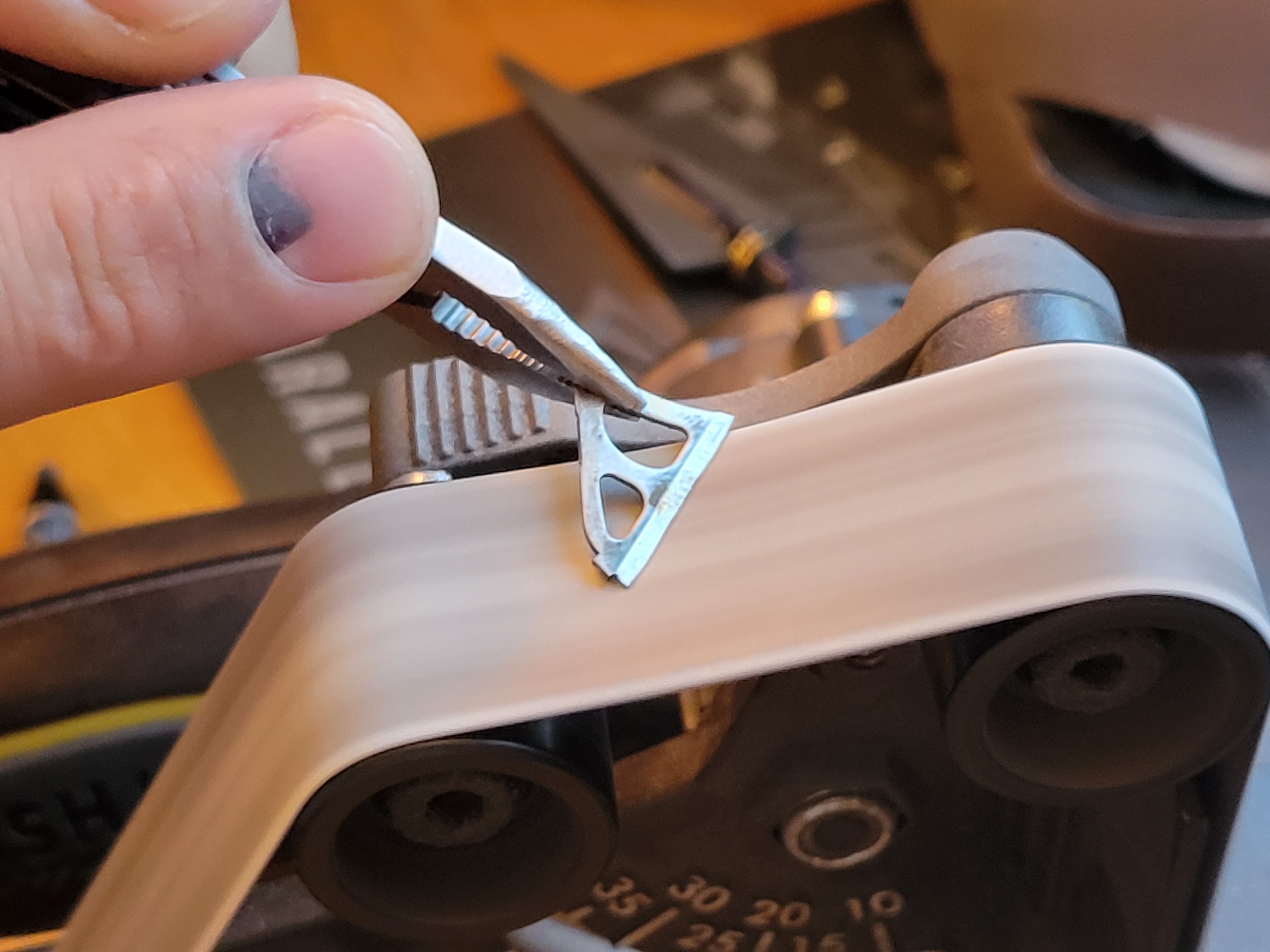
Photo by Drew Conover
Some people laugh when they hear about sharpening replaceable blades because, well, you’re just supposed to replace them. Right? Again, these aren’t always that sharp out of the box, and why replace them if they can be reused? Stretch your hunting dollar a bit further and sharpen them.
For replaceable blades, I always remove them from the head, and sometimes if they are really small, I will hold them with needle nose pliers. The process for stones or belts will be the same. Hold the blade at a steady angle and raise a burr either by moving back and forth across the stone, or across the belt.
Repeat for the other side, and for each blade. Work through this process with finer abrasives, and then strop to a nice polished edge. Try to match the angle that is already ground into the blade as closely as possible. If the blades have been used, examine the blades carefully to make sure they aren’t bent. A bent blade will need to be replaced. If the blades are new, you may only need a few passes on the fine stone, or a minute on the strop to really get them sharp.
Replaceable blades are generally made from softer steel because it’s less expensive, takes a good edge, and doesn’t need to hold an edge long. So, sharpening (removing and reshaping material) usually happens pretty fast.
Replaceable blade heads usually have a sharp ferrule up front to initiate the cut and break bone ahead of the blades. Many of the ferrules can be dressed and touched up on the stone as they get nicks and rolls in the edges. The sharper the leading edge of the head is, the more likely you are to get a pass through. Stones are generally better for this because the flats on the ferrule can be laid flat on the stone and run back and forth until the edges are sharp again. A belt will have the tendency to flex and convex the tip and trailing edge.
FAQs
Yes. Sharp heads lead to more bleeding, better penetration, and a much higher probability of having two holes pumping blood, rather than one.
First off, slow down. Most beginners rush the process. Slower passes are easier to control. Also, you can use your fingers as depth guides. Hold the broadhead in way that your fingertips are just touching the stone when the head is at the correct angle. Keeping your fingertips in contact with the stone at all times will help you know that your angle is consistent.
The most obvious will be bends or cracks in the blades or ferrules. Less obvious is when blades thin out. Many mechanical blades are thin and relatively weak to begin with, so sharpening them several times, especially if you have to grind away edge damage, can thin the blades out to a point where they are too weak.
Final Thoughts
Broadheads are like bullets in that they are what actually does the killing during a hunt. There is a whole lot that goes into delivering a bullet or broadhead to the intended target, but the moment of truth happens when the payload is delivered. Having the sharpest broadhead possible will help you get more game, give you more confidence, and give you shorter blood trails. Whatever head you choose for your hunt, just make sure its razor sharp.
The post How to Sharpen Broadheads appeared first on Outdoor Life.
Source: https://www.outdoorlife.com/gear/how-to-sharpen-broadheads/





